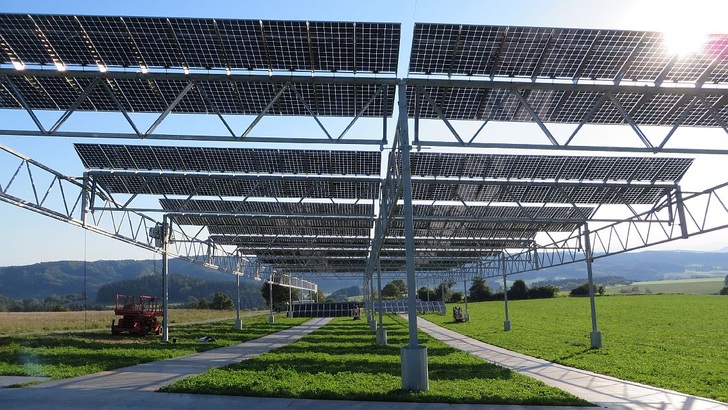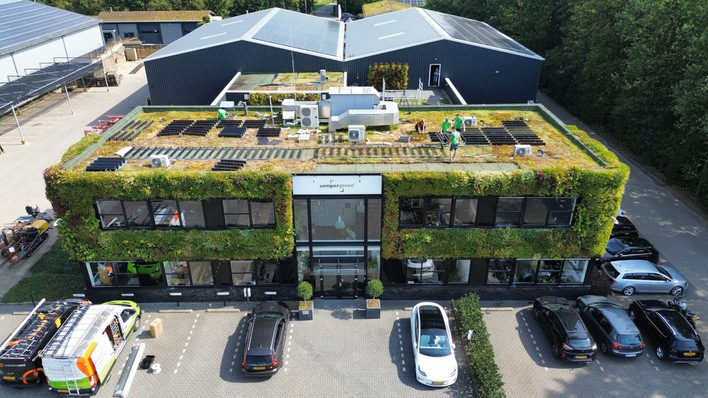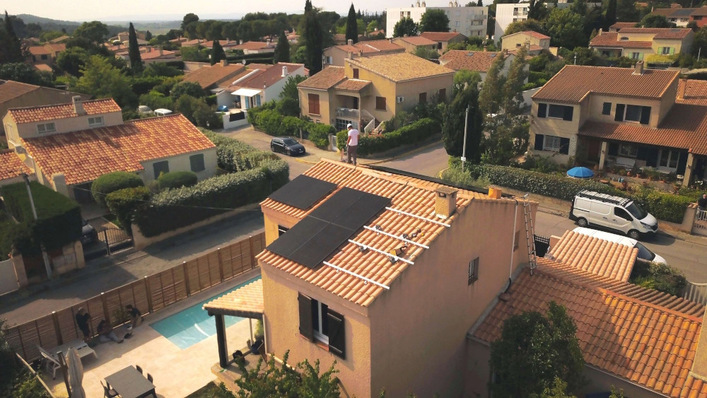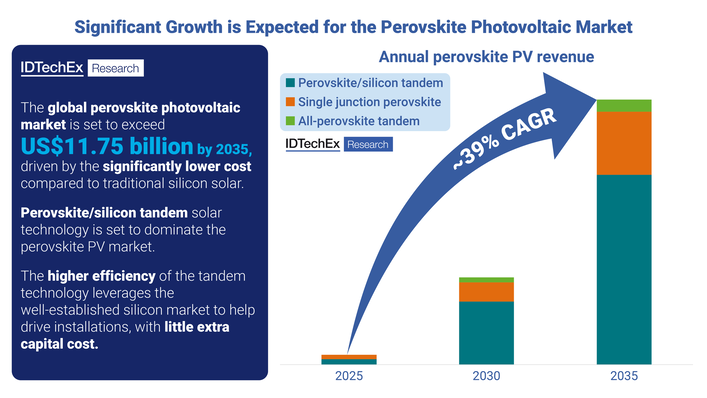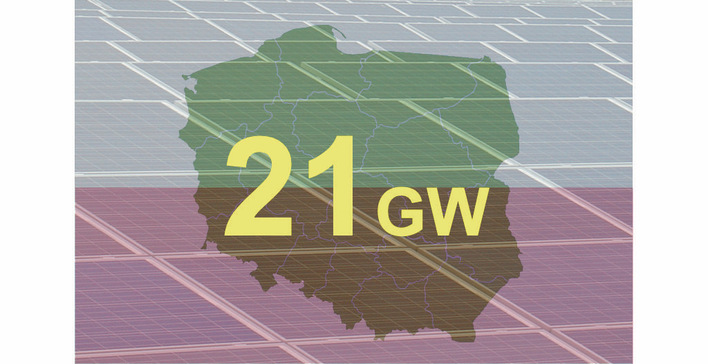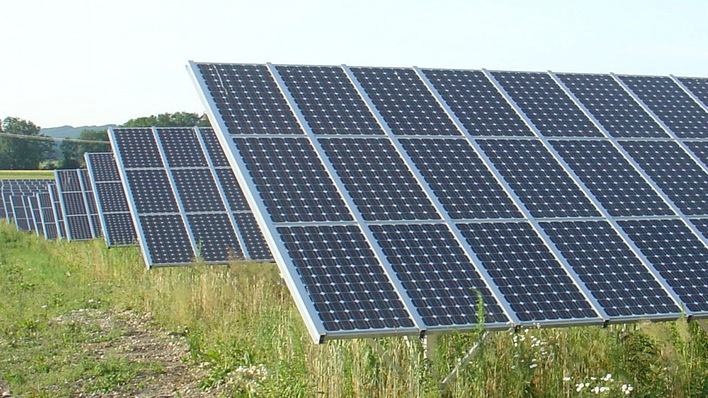In 2016, the cultivated land surrounding the agriculture community of Heggelbach near Lake Constance was turned into the first test site for agrivoltaics. A total of 194 kilowatts of solar panels were installed five metres off the ground. Bifacial solar panels by Solarworld were used. The structural elements were manufactured by the Austrian supplier Hilber Solar. 95 percent of the land underneath the solar array can be put to agricultural uses. The solar panel array is 25 metres wide and 136 metres long. The project was planned by Baywa r.e. and they also take care of monitoring operations.
So it took 35 years for an old idea by Adolf Goetzberger to be implemented. In a presentation back in 1981, Goetzberger had preached his vision of getting twice the energy out of farmland: both in the form of solar energy and as food.
A vision has become real
This vision has now at last been realised. In Heggelbach, the struts of the supporting structure are spaced far enough apart that agricultural machinery such as tractors and combine harvesters can easily pass between them. “This way, we can alleviate the use conflict for a given piece of land,” Tabea Obergfell explains. She has been a research associate at the Fraunhofer ISE for the last five years, prior to which she studied in Tübingen and Kassel. She is a member of the project team that seized upon Goetzenberger’s idea and turned it into a reality. “This allows farmers to lower their energy costs. They can even sell the electricity to their neighbours.”
Although this pilot installation is located at Lake Constance, the actual market is far further south: “The solar panels partially shade the ground,” Obergfell elucidates. “And in some arid and hot regions, this is what will make agriculture viable.”
Prevent further desertification
Large areas of the world are threatened by aridification and the salinisation of the soil that goes along with it. Climate change is exacerbating this effect; deserts are spreading. Many high-yield crops cannot be cultivated under the bright sun in the latitudes between 35 degrees north and 35 degrees south. Only millet will grow, and sparsely at that. Without irrigation, the soil is almost barren, which explains the chronic food shortage in many areas of the world. “We can use the power from the solar panels to run irrigation pumps,” Tabea Obergfell adds.
In the hot and dry areas of the world, also known as semi-arid or arid, electricity mostly means one thing: water. And water means agriculture, or in other words: life. The Heggelbach installation is not the first attempt to combine solar energy and agriculture. In France, 50 kilowatts have been installed as a test, in Italy as much as three megawatts. China has as much as 700 megawatts’ worth of such installations, Chile 15 kilowatts and Japan 50 kilowatts. Some of these systems are designed chiefly for greenhouses or non-mechanically harvested crops. Huawei in China has mounted their panels at three metres off the ground. In Italy, some arrays are mounted on heliostats.
Testing under real-life conditions
What all of the above projects are not, however, is accompanied by scientifically rigorous research. “The installation near Lake Constance will be closely monitored and evaluated both from the farming side and with an eye to the solar technology,” Obergfell predicts. “We are testing the solar installation under the real-life conditions of a Demeter-certified farm.”
Prior to the installation of the arrays, extensive simulations were undertaken to determine the most practical shading of the ground. Assuming a panel array of 100 by 100 metres, the scientists simulated various panel orientations, different substructures and distances between the panel rows. “If the arrays are oriented due south, the shading on the ground is unevenly distributed,” Tabea Obergfell explains. “If oriented towards the southwest, i.e. turned by 45 degrees, the irradiation is more even and thus much better for the crops.”
However, in this case the panels generate about five percent less electricity. “We see that as rather negligible.” The key was to find a good compromise: the happy medium between a solar park without agriculture and a farm without a photovoltaics.
Potatoes like the shade
But first results from the trials near Lake Constance are already indicating that these are two sides of the same coin. For instance, if one defines the spacing of the panel rows according to the amount of light that reaches the ground, 2.8 panel widths have proven effective. “This allows 60 percent of the light to come through,” Obergfell analyses.
In our latitudes, this powerful combination of PV and agriculture is most suitable for crops that thrive in shade. Potatoes are very suitable, while on the other hand rape seed requires more sun and is thus less well-suited. Maize also requires a lot of direct sunlight to ripen and does not get along well with PV. “The greatest challenge for farmers is to establish the crop rotation that brings the highest yields,” Obergfell says.
The Heggelbach installation covers about a third of a hectare. The panels are installed at a height of 5.5 metres. Because they are mounted overhead, glass-glass panels were used. Glass-foil panels are not approved for such an application.
The supports are spaced 19 metres apart, enough space for a combine harvester to pass through. The installation’s total output is 250 kilowatts. Of course, the costs for such a complicated substructure are much higher than for a standard solar park. Furthermore, the installation requires a long cable to the grid-connection point. Tabea Obergfell confirms: “That is why the costs are adding up to 3,400 euros per kilowatt.”
50 gigawatts in Germany
3,400 euros per kilowatt. When PV got going 20 years ago, the kilowatt cost more than 6,000 euros. On the other hand, agrivoltaics is a huge market for: In Germany alone there would be enough potential agricultural land for 50 gigawatts in solar output. In contrast to solar parks, this land could still be used for agriculture.
Currently, there is no feed-in tariff for these solar yields, because farmland is not covered by the Renewable Energy Law (EEG). Also, fields lose their EU subsidies, if they are put to use for PV. But there is one decisive advantage that will soon outweigh all these difficulties: By making the diesel generators used for electricity generation obsolete, the solar electricity is already economical.
The electric tractor
Agrivoltaics provides a charging point anywhere on the field, no matter how extensive it might be. Fully electric tractors and combine harvesters will be on the market very soon. John Deere, for example, are already working on this.
In combination with large batteries, solar energy will be able to be tapped anywhere and at any time. And: The shade that the arrays provide will be what will actually make agriculture feasible in many parts of the world. A vision even older than Adolf Goetzberger’s suggestion from 1981 is becoming possible: Bringing new life to the desert. (Heiko Schwarzburger)
Read more about energy storage
Stay informed, get our newsletter twice a week. Register here: http://www.pveurope.eu/Newsletter
Related news:
http://www.pveurope.eu/Products/Solar-Generator/Solar-modules

